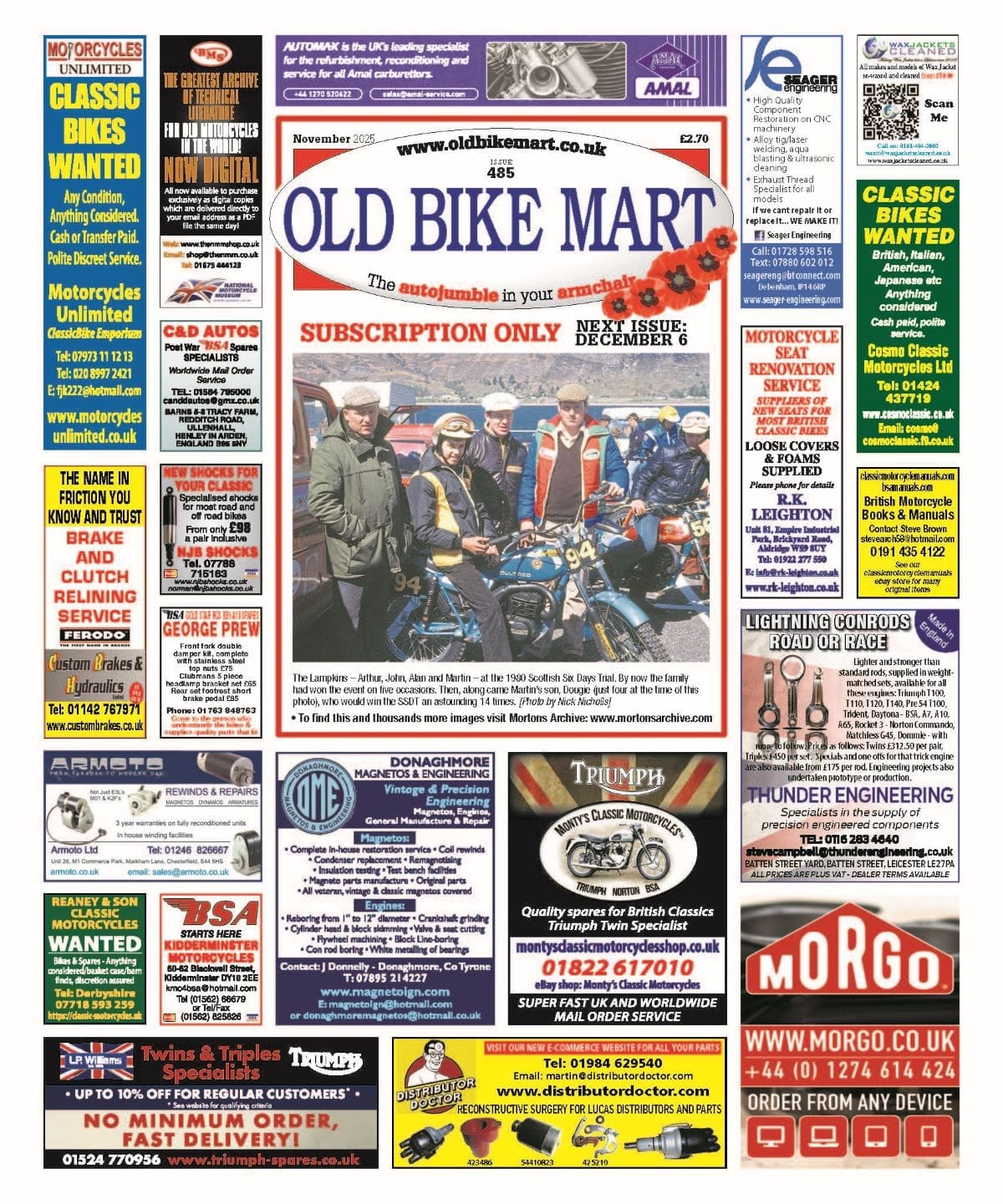It’s a brave move these days to create a personal take on such a model as the BSA Gold Star. Here’s one man’s amazing take on a classic – and it’s not even silver!
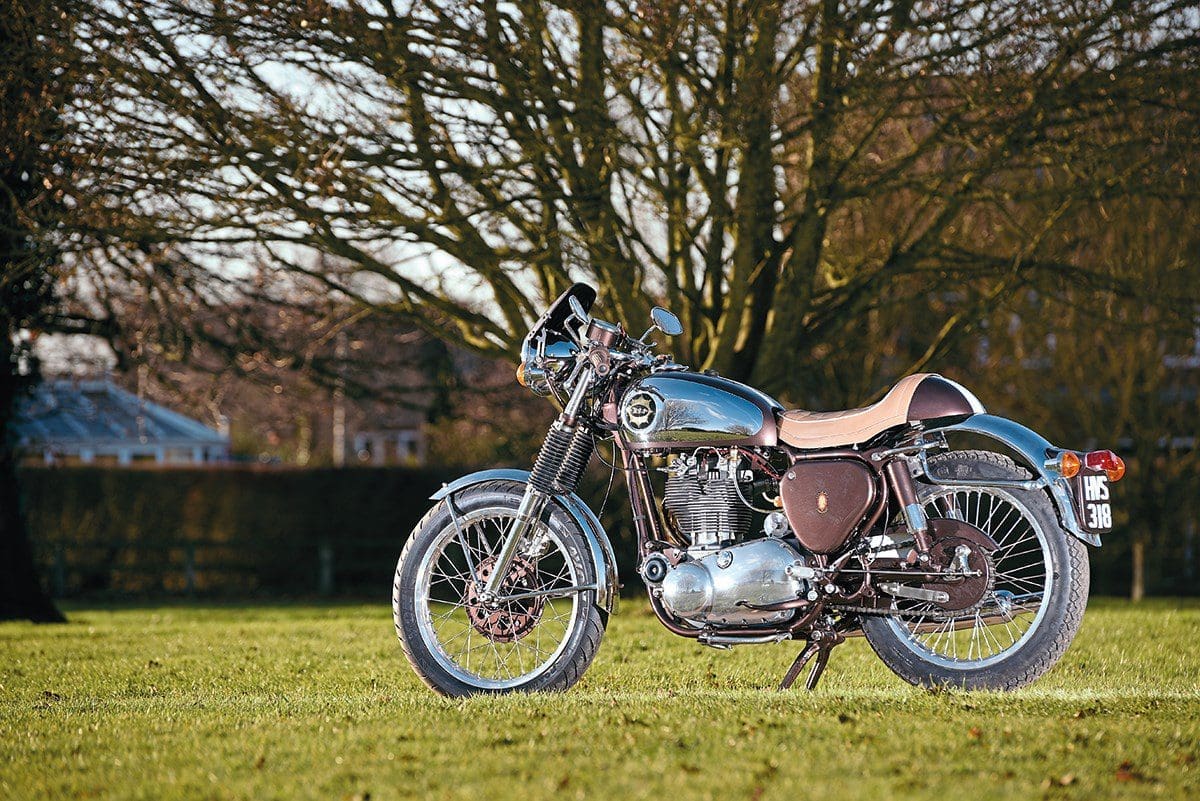
Words and photography by Matt
Enjoy more classic motorcycle reading, Click here to subscribe to one of our leading magazines.
The story sounds familiar. Like so many of us, Matthew Marsham has always liked bikes – modern, fast ones when he was younger and as he, erm, gained years, the older bikes appealed more. As I went to see the professional painter, mechanic, restorer and talented competitor of American Western horse shows at his workshop, I squeezed by some covered bikes; an immaculate three-cylinder Honda NS400R and a Honda CL350, also immaculate, and oh, a wonderful, restored and modified ‘50s American Ford pick-up truck fitted with a potent V8, with wide arches to cover racing wheels. Naturally.
But to the job in hand. Sitting on the bench is a bike with a BSA DBD engine in, but the body is less instantly recognisable. It’s a BSA Gold Star DBD34, in road trim, but most individual.

“I saw it on the BSA Facebook page for sale,” explains Matthew. “The owner had sadly passed away and his brother-in-law had put it up for sale, but then Covid struck and he took it off as he didn’t want people coming round looking at it. The bike then reappeared later and I messaged him saying that I didn’t even want to see it. I wanted a project and that it was ideal.”
“I bought it just after first lockdown. Restoring it took me three months – that’s how long these restorations seem to take me, in between jobs, along with digging for detail.”

It transpires that the previous owner was quite a character, well-known in the BSA world, and when Matthew first saw it there were panniers and an enormous top box fitted as he used it to tour abroad regularly. “The bike wore stickers from all the countries they had visited!” He also used to fit a sidecar to it, so there were fittings for that, and to aid comfort some Catalina handlebars and tank (the Catalina was a US-only off-road model with lights and could be fully road registered, named after the race that took place on Santa Catalina Island, just off the Californian coast. It was also the last iteration of the Gold Star).
“The owner’s mate was in the RAF and the frame was all painted in aircraft undercarriage grey enamel which was as hard as concrete, so I had to sand it down and it’s still under there, protecting,” laughs Matthew. Later, he’d then painted the frame black.
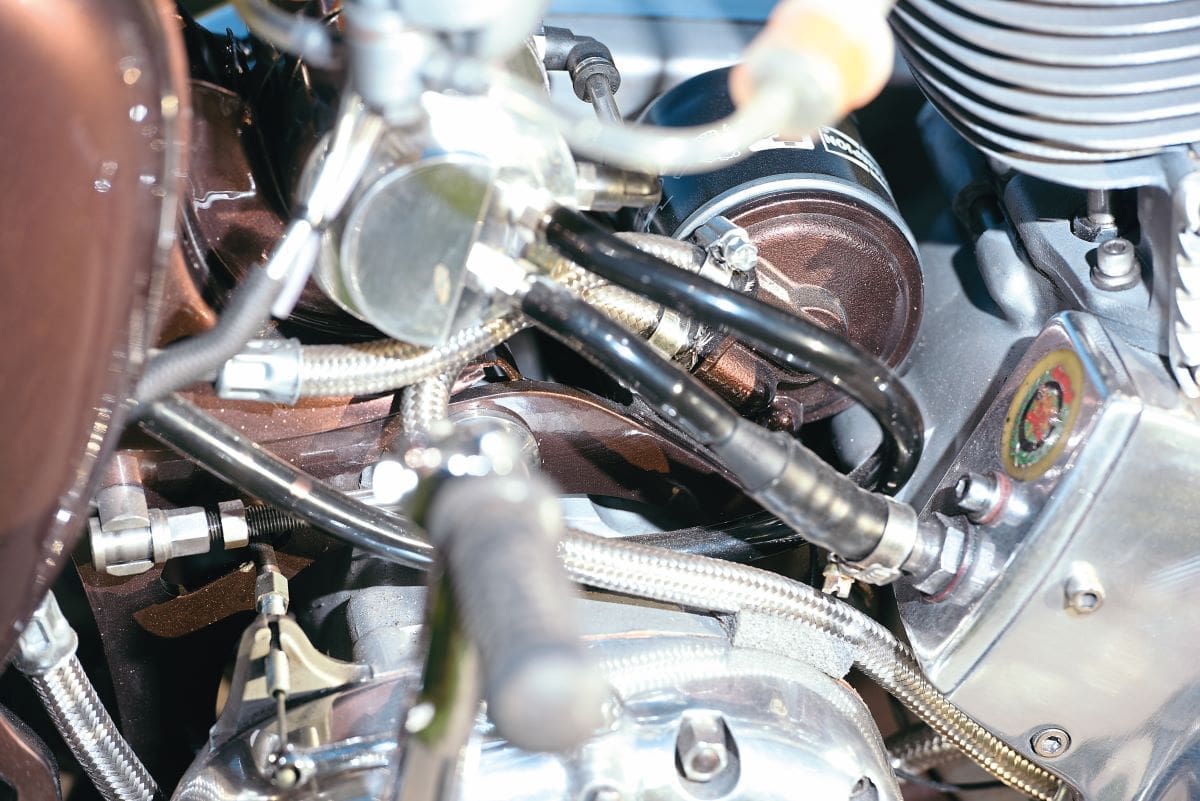
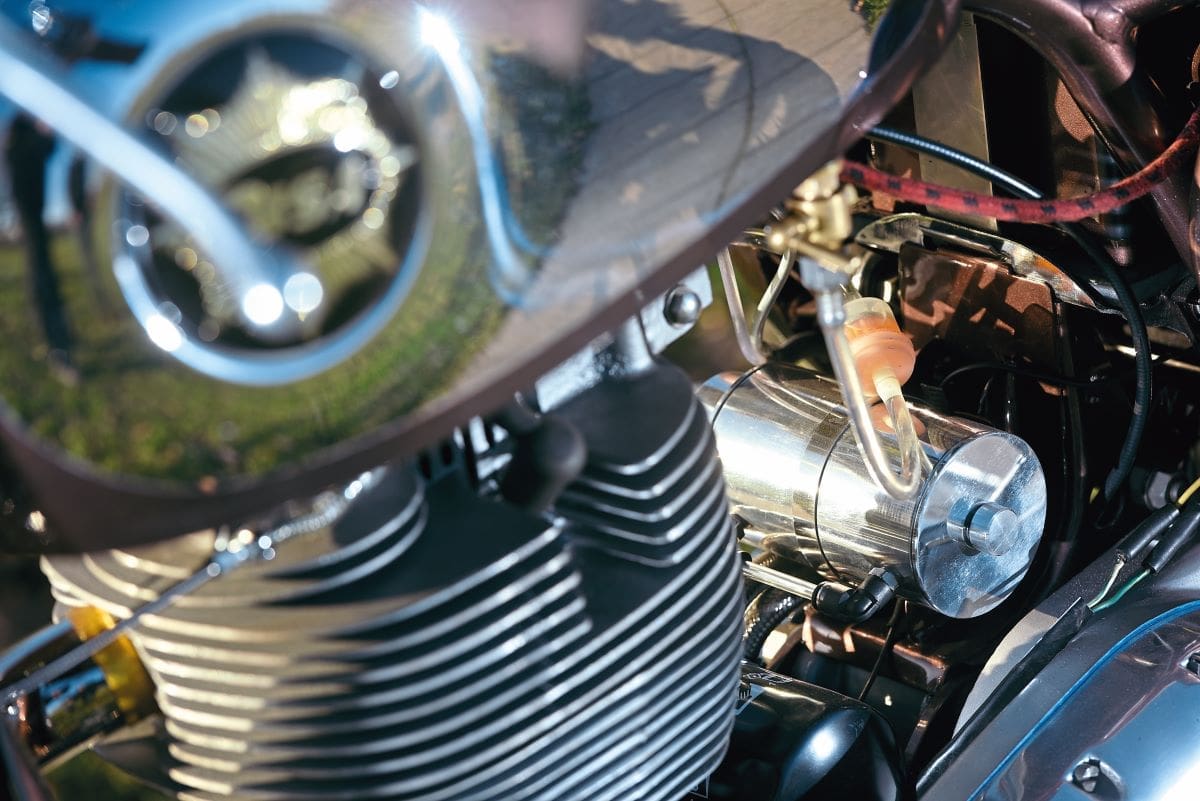
“When I got it the DBD engine was fitted but it still had the early Gold Star mudguard on it and the Gold Star wheel, but I fitted the twin-leading shoe as he had the standard front brake and it also wore an A65 speedo and loads of weird stuff fitted for touring. Seems odd now, how you see Gold Stars all original and almost unusable, but back then you rode what you had.”
There’s more to this bike, as the previous owner raced it and had evolved the engine by modifying the right-hand engine case completely, and improving the ignition with pick-up from the machined exhaust cam using a magneto cam plate and points. Quite bizarre, but easily adjustable and very clever.

Matthew used the club to find more about its history, which reads a little like Trigger’s broom. “This bike was a DBD34 originally, then in 1975 as a Catalina with an earlier BB engine, but someone nicked the cases when it was apart at some point, so he rebuilt it with B31 cases, but I’ve checked all the parts numbers and they’re now all Gold Star. So, did he find some new ones? At some point it was also a 400cc, via the common B31 practice of using a T140 piston and boring the barrel out to suit, and finally it had a brand new sleeve fitted and became a 350cc because his arthritis had got worse. He modified it so he could still ride.” Now the spec at least is back to where it should be – DBD cases with a Gold Star crank and the addition of high-lift cams; it’s just a 350 now.
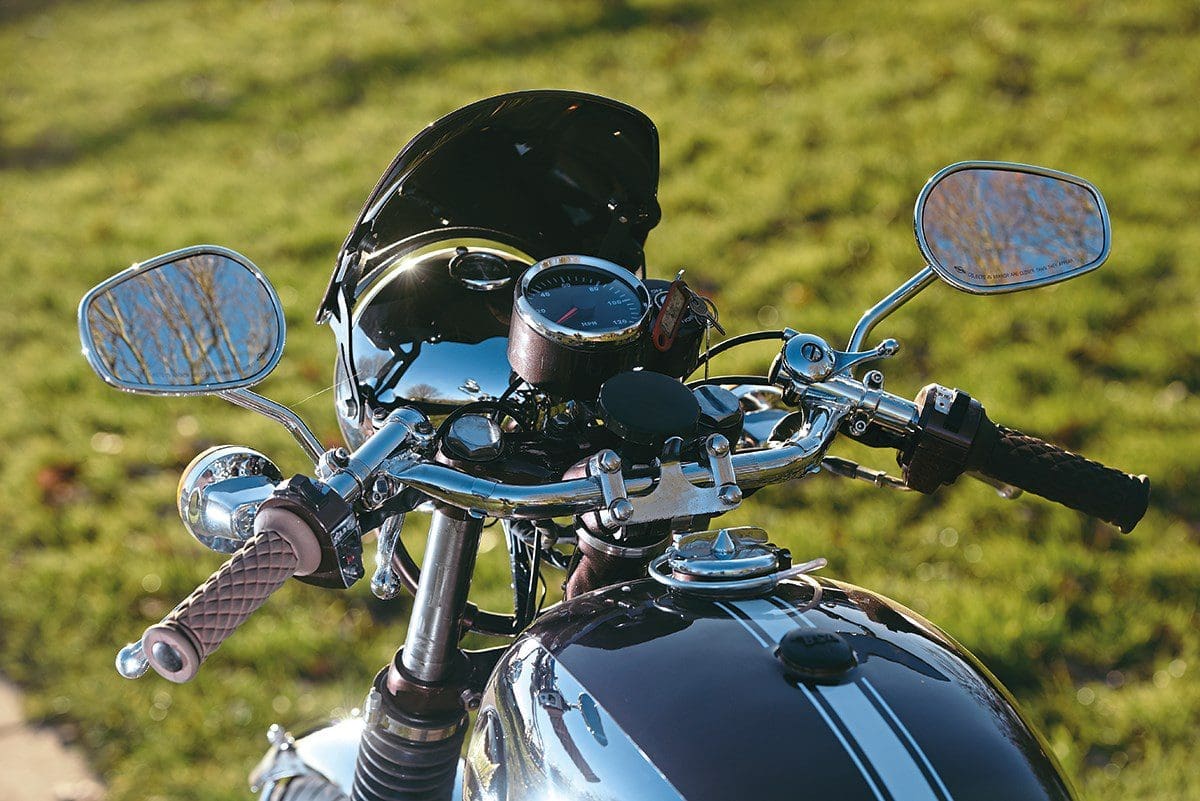
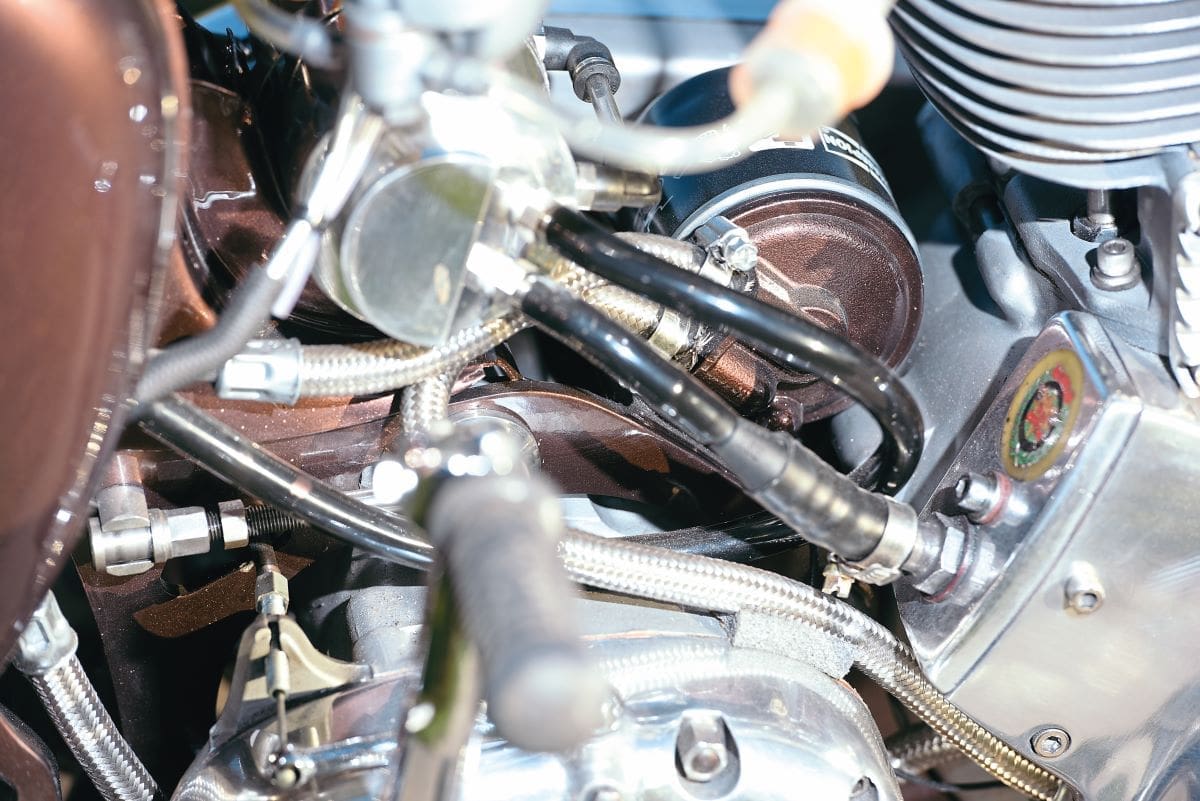
From a restoration point of view, the bike was complete and it ran, albeit not all original – but Matthew wasn’t worried about that as he knew what he wanted. “The previous owner’s brother-in-law said the engine had only been gone through 18 months before, but it was in a state and oil was peeing out of everywhere! It has a Gold Star crank but the output shaft off a B31 alternator model and the owner had fitted it on the crank. He’d done a really good job and obviously knew these engines well.
“While apart, I found there was a brand new liner and despite large valves, it has standard cams. Changing them would be easy and make it run even better, but this is a road bike and I like it the way it is – at the moment.”
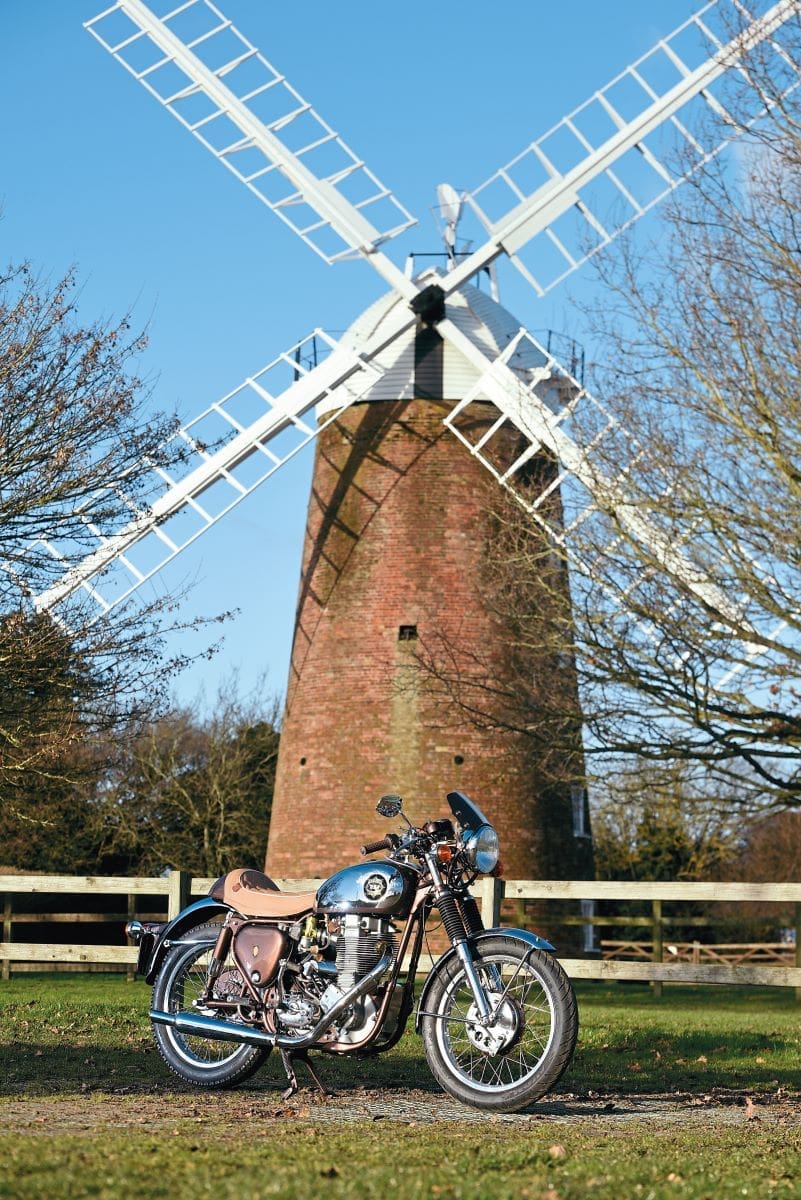
“When I first got it running, it was really flat and hadn’t been run for a while; it did start but ran really bad. It was so flat when I took it up the road. I thought, ‘this is rubbish’ – gutless!”
Getting back, Matthew discovered it had been set up with no advance. “Someone had backed it right off to 24 degrees – it should be at 38 degrees, which is full advance. Basically, it was fully retarded when they got it running. I put a new pipe on and it went blue the first time I rode it! It’s now at full advance all the time and it goes alright.” Following Matthew a short distance to find a photo location (in the middle of winter), I can testify that it does indeed go a lot more than alright.
But the ignition timing wasn’t the only problem when Matthew was working on the engine. “When I first took it out it still felt terrible. The carb is a mk1½, not a concentric, that’s got an idle jet at the front, not in the tube, and it was blocked solid. I cleaned it up and had it ultrasonically cleaned, then it ran better, so then I sorted the ignition. Once running alright, I found he’d lowered the gearing for using the sidecars, so when you got to 70mph it was screaming a bit!
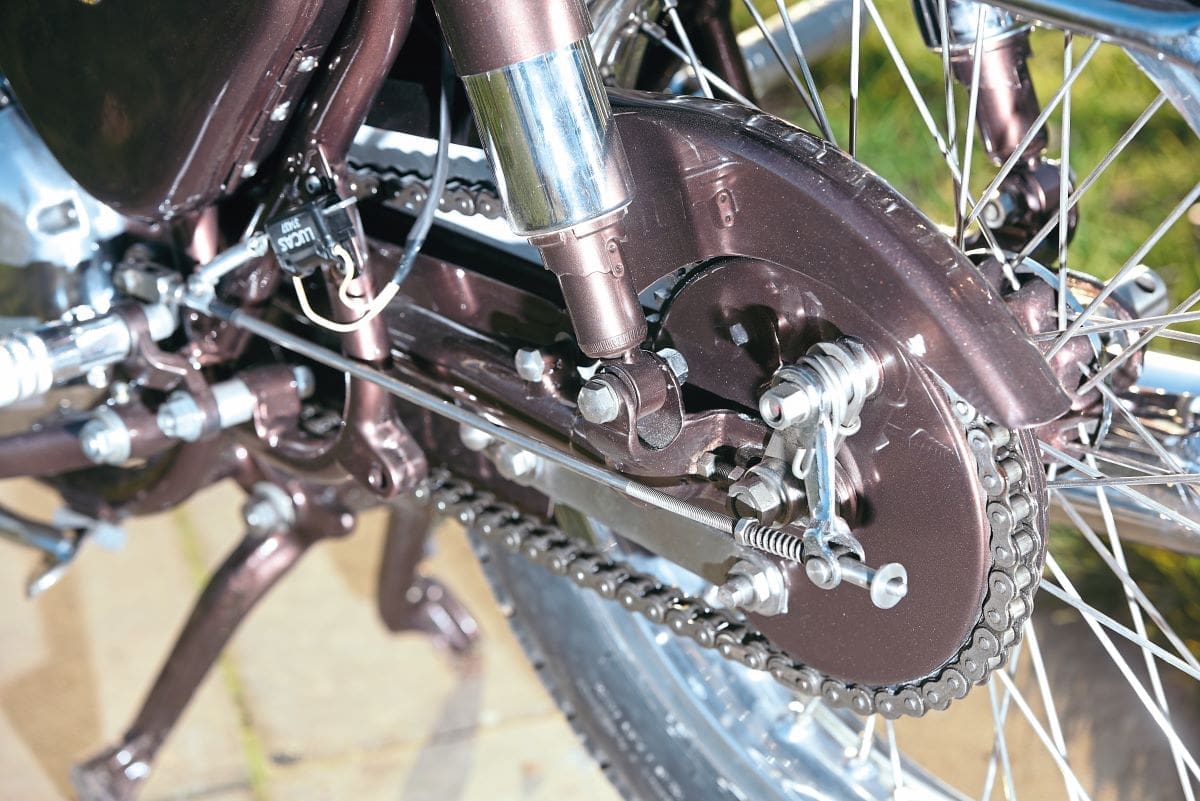
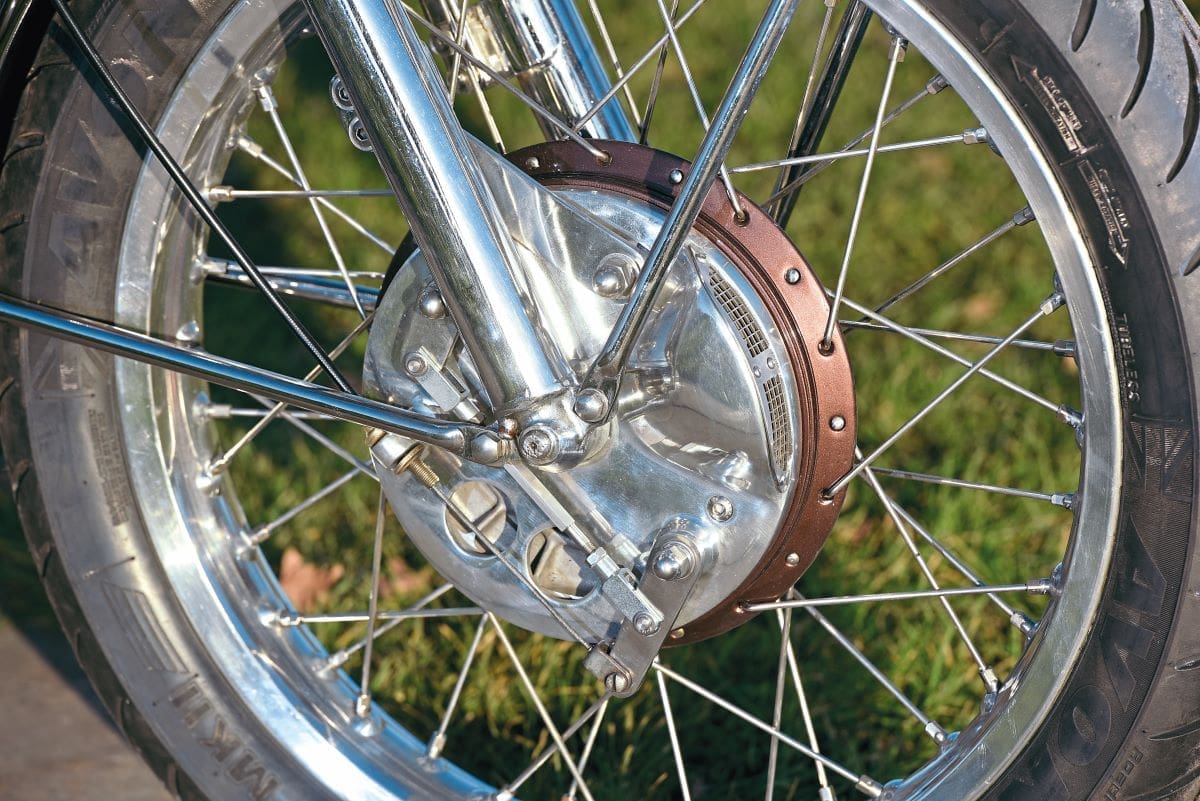
“I haven’t changed the engine; it’s exactly as it was – apart from rebuilding the head as it was knackered. I’ll tell you, the head is a monster, the valves are so big – it’s got cutaways in the liner to clear them. I’m up to a 190 jet in at the moment, but when you’re nailing it the engine holds back slightly, so I think I need at least a 230 in there. I’ve quietened it down, too, it’s so bloody noisy! I’ve put some baffles in to stop it being straight through. Sounds more like an AJS than a Gold Star now.” Rest assured, it still sounds like a Gold Star, just a little more restrained.
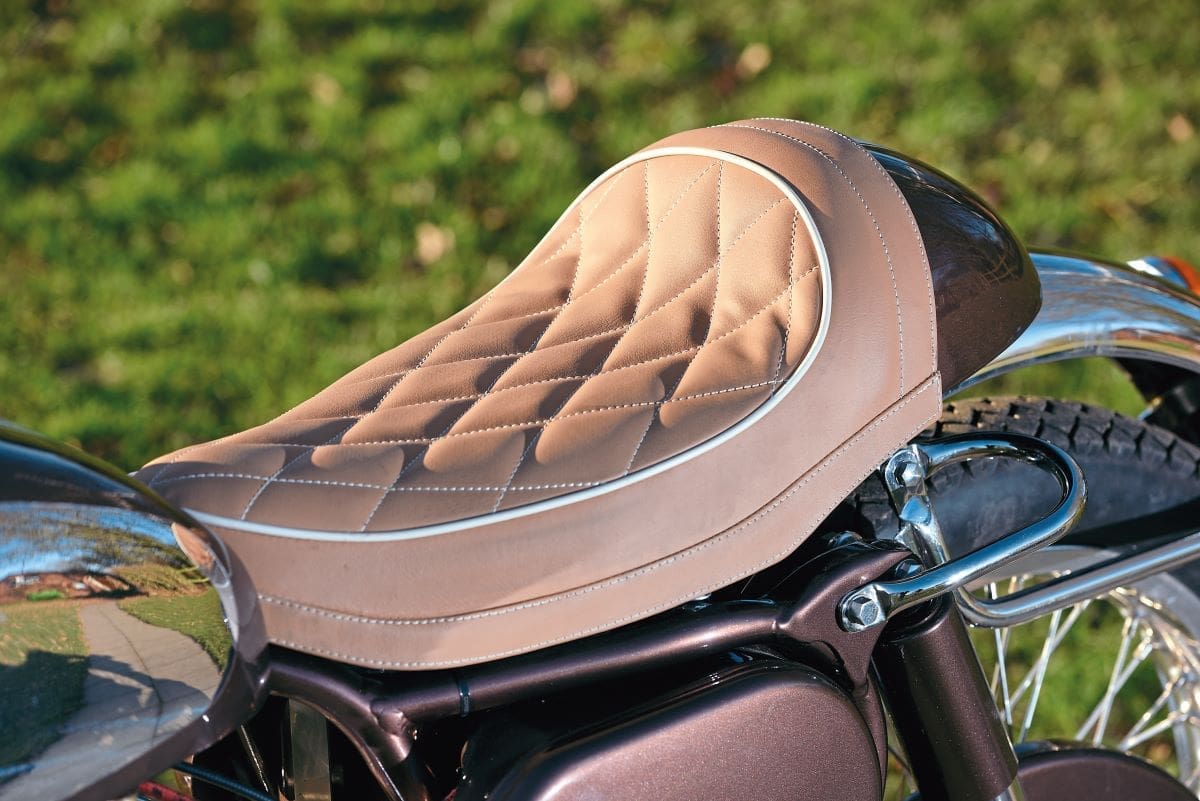
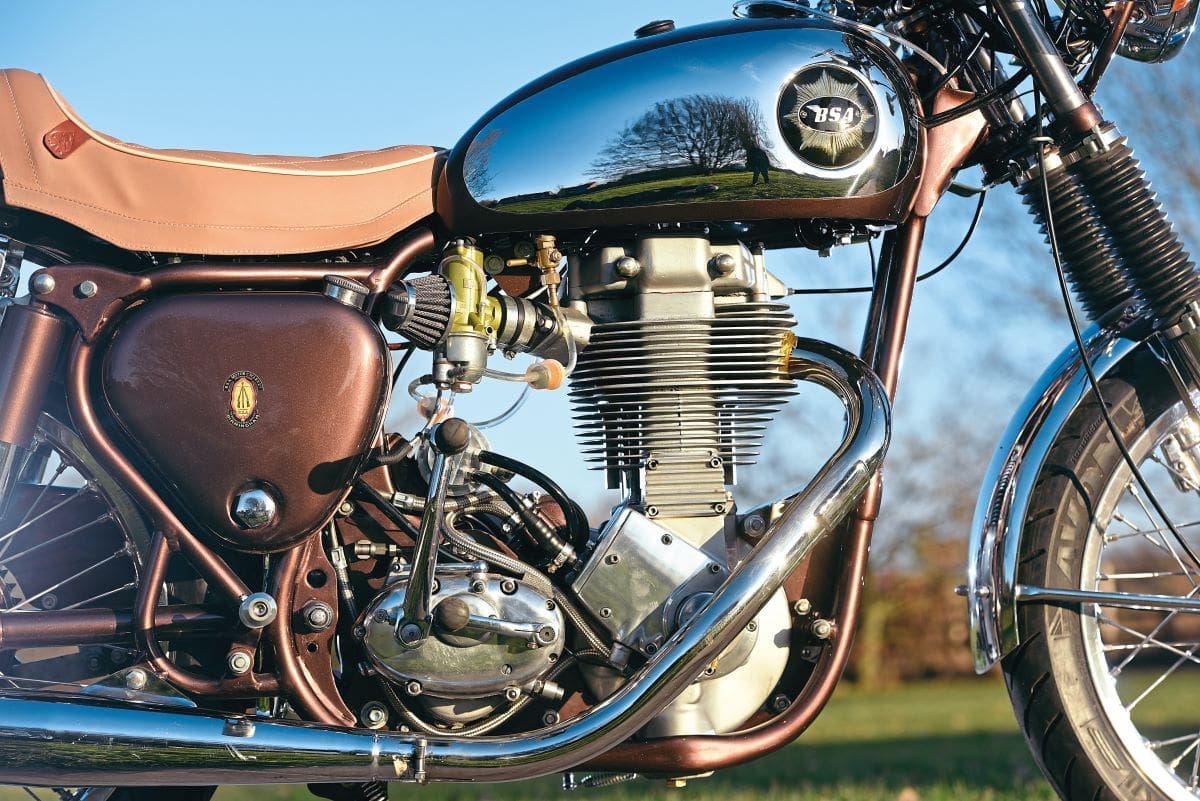
The standard gearbox was checked and rebuilt but hid no problems. Then it was a case of the frame and bodywork. Matthew knew what he wanted as he’d seen a colour from the hot rod world he liked. The lethargic process of making sure parts were in the right shape – like the toolbox cover fitting on the toolbox, rubbing down, repairing and filling dents and getting them all ready for paint – took time and patience. The frame, swingarm, shock bodies, yokes, tank, seat hump, fly screen (a modern Triumph part), clocks, switchgear (Honda parts), numberplate bracket, oil tank, toolbox, chainguard, hubs and other parts, once ready, were etch primed and finished in this gorgeous shade of dark bronze, which although more like a 1970s colour, works brilliantly, especially in the sun. It doesn’t scream ‘look at me’, but stands out – a tricky task to pull off.
Once painted, the rebuild began, with stainless steel nuts and bolts and other parts Matthew had collected. “I wanted a café racer look but didn’t want clip-on handelbars as I can’t stand that riding position, so I fitted so higher Ace bars. They have the extension on them for the valve lifter, which is great, and the shocks are one inch shorter to fit me. I bought new mudguards from George Prew (renowned Gold Star specialist and author of The Gold Star Book). The rearset footrests went on to replace the forward controls that had been used for touring and now, for me, the position is perfect.”
To add to the usability, Matthew fitted 1970s Honda switchgear and indicators, along with a mirror. These things would not be noticed on a modern bike, so why not have them on an old bike in today’s traffic? The carb had a repaint too, and now wears a filter.
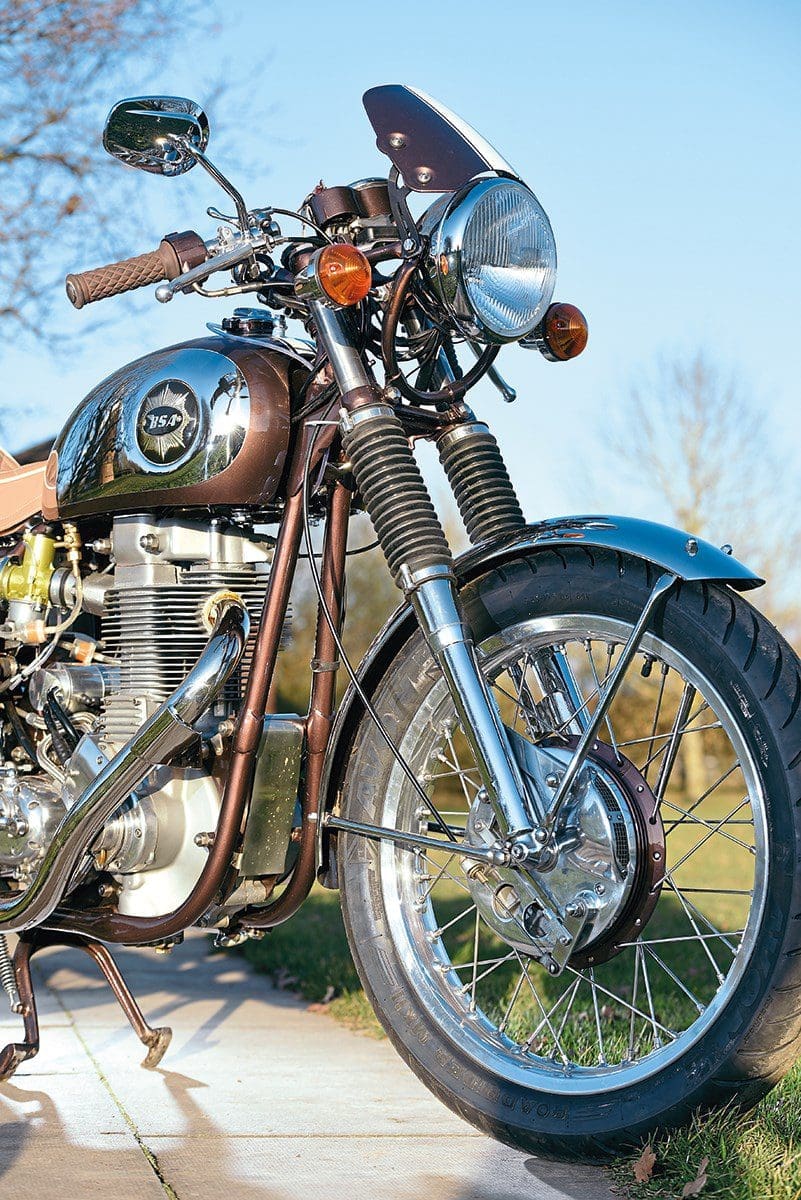
“I fitted a standard-sized tank as the Catalina tank only holds two gallons! It was a copy from India. It’s not exactly the correct shape and a lot of people moan about Indian tanks, but I’d rather have a new one than a 60 year-old rotten piece of rubbish. It came chromed, so you mask up the parts for painting and you really have to rough up the parts to paint and use a good etch primer to give a key. The high-build primer follows, then the topcoat and lacquer, put the stripes on and then lacquer it again over the top. The engine is painted too, not blasted or bare. I clean them up, etch prime, then put your silver on and use a flat-matt lacquer to give it an unpainted look – except it’s easier to clean. Just watch out, though – the new ethanol-rich fuel will remove even the most resistant of paint quickly, so don’t spill any.”
The Avon SM tyre at the rear came with the bike and was joined by an Avon Roadrider at the front. Coil was fitted under the seat, whereas it’s in the toolbox now. And the external oil cooler has been moved for a neater look with a welded bracket to the engine plate, with the braided hose, too. The forks were rebuilt, Matthew made a new wiring harness and incorporated a new rectifier, it still uses the original ammeter and the false magneto is now an oil catch tank.
The seat is a steel pan and because Matthew couldn’t find a seat unit he liked, he made the hump from fibreglass – no mean feat in itself: “There’s loads of café racer seats available but I didn’t like any of them.” Atop, the seat was made by an ex-Lotus trimmer who created a beautiful perch from leather, with piping and a perfect flow to the line from tank, to seat, to hump. Adorning both sides are commonly available grab rails.
Matthew has given the chain guard a cutaway to make getting to the chain a lot easier and “I suppose makes it a little lighter”. Next to that is the shortened brake pedal, made to work with the rearsets. “They wanted too much for a shorter one, so I did it myself. The proper Gold Star one looks like a banana.” Clubmans headlight mounts are on the front holding the light and give that Gold Star look.
The people who have seen it so far really like it. “One chap said to me, ‘the first thing I did when I bought my Gold Star brand new was to chuck this away and chuck that away and made it to how I wanted it. Everyone seems to worry about their bikes being like they left the factory all the time – but they all look the same!’ I have built mine to ride, and how I want it to look.”
Matthew obviously loves restoring his bikes and puts a lot of attention into the detail. The Hondas he’s rebuilt are as they left the factory, but the Gold Star cried out for something a little different, especially as the previous owner had developed the engine from standard, to racing, to touring. It’s a bike that has always morphed into what is best for the time, like when it went from being a 500 to a 350 for easier starting. This bike is one of life’s survivors – and Matthew has helped it survive a little longer.

